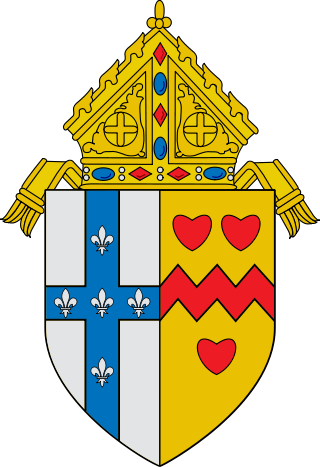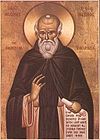
The liturgical year, also called the church year, Christian year or kalendar, consists of the cycle of liturgical seasons in Christian churches that determines when feast days, including celebrations of saints, are to be observed, and which portions of Scripture are to be read either in an annual cycle or in a cycle of several years.
In the liturgical calendar of the Roman Rite, a solemnity is a feast day of the highest rank celebrating a mystery of faith such as the Trinity, an event in the life of Jesus, his mother Mary, his earthly father Joseph, or another important saint. The observance begins with the vigil on the evening before the actual date of the feast. Unlike feast days of the rank of feast or those of the rank of memorial, solemnities replace the celebration of Sundays outside Advent, Lent, and Easter.

The Tridentine Mass, also known as the Traditional Latin Mass or the Traditional Rite, is the liturgy in the Roman Missal of the Catholic Church codified in 1570 and published thereafter with amendments up to 1962. Celebrated almost exclusively in Ecclesiastical Latin, it was the most widely used Eucharistic liturgy in the world from its issuance in 1570 until the introduction of the Mass of Paul VI.

The calendar of saints is the traditional Christian method of organizing a liturgical year by associating each day with one or more saints and referring to the day as the feast day or feast of said saint. The word "feast" in this context does not mean "a large meal, typically a celebratory one", but instead "an annual religious celebration, a day dedicated to a particular saint".
In the Catholic Church, holy days of obligation or precepts are days on which the faithful are expected to attend Mass, and engage in rest from work and recreation, according to the third commandment.

Whit Monday or Pentecost Monday, also known as Monday of the Holy Spirit, is the holiday celebrated the day after Pentecost, a moveable feast in the Christian liturgical calendar. It is moveable because it is determined by the date of Easter. In the Catholic Church, it is the Memorial of the Blessed Virgin Mary, Mother of the Church, marking the resumption of Ordinary Time.
The Litany of the Saints is a formal prayer of the Roman Catholic Church as well as the Old Catholic Church, Anglo-Catholic communities, and Western Rite Orthodox communities. It is a prayer to the Triune God, which also includes invocations for the intercession of the Blessed Virgin Mary, the Angels and all the martyrs and saints upon whom Christianity was founded, and those recognised as saints through the subsequent history of the church. Following the invocation of the saints, the Litany concludes with a series of supplications to God to hear the prayers of the worshippers. It is most prominently sung during the Easter Vigil, All Saints' Day, and in the liturgy for conferring Holy Orders, the Consecration of a Virgin and reception of the perpetual vows of a religious or a diocesane hermit.
In the Latin liturgical rites of the Catholic Church, a commemoration is the recital, within the Liturgy of the Hours or the Mass of one celebration, of part of another celebration that is generally of lower rank and impeded because of a coincidence of date.
This article lists the feast days of the General Roman Calendar as they were at the end of 1954. It is essentially the same calendar established by Pope Pius X (1903–1914) following his liturgical reforms, but it also incorporates changes that were made by Pope Pius XI (1922–1939), such as the institution of the Feast of Christ the King, and the changes made by Pope Pius XII (1939–1958) prior to 1955, chief among them the imposition of the Feast of the Immaculate Heart of Mary upon the universal Church in 1944, the inscription of Pius X into the General Calendar following his 1954 canonization, and the institution of the Feast of the Queenship of Mary in October 1954.
"Octave" has two senses in Christian liturgical usage. In the first sense, it is the eighth day after a feast, reckoning inclusively, and so always falls on the same day of the week as the feast itself. The word is derived from Latin octava (eighth), with dies (day) understood. In the second sense, the term is applied to the whole period of these eight days, during which certain major feasts came to be observed.

The Solemnity of Mary, the Holy Mother of God is a feast day of the Blessed Virgin Mary under the aspect of her motherhood of Jesus Christ, whom she had circumcised on the eighth day after his birth according to Levitical Law. Christians see him as the Lord and Son of God.

Prior to the revision of the Anglican Church of Canada's (ACC) Book of Common Prayer (BCP) in 1962, the national church followed the liturgical calendar of the 1918 Canadian Book of Common Prayer. Throughout most of the twentieth century, the situation in Canada resembled that which pertained in much of the Anglican Communion: There was uncertainty as to whether post-Reformation figures could or should be commemorated. In the words of the calendar's introduction, "New names have been added from the ancient calendars, and also from the history of the Anglican Communion, without thereby enrolling or commending such persons as saints of the Church." The 1962 revision added twenty-six post-Reformation individuals, as well as commemorations of the first General Synod and of "The Founders, Benefactors, and Missionaries of the Church in Canada." Of the calendar days, twenty-eight were highlighted as "red-letter days" — that is, days of required observation.
This article lists the feast days of the General Roman Calendar as approved on 25 July 1960 by Pope John XXIII's motu proprioRubricarum instructum and promulgated by the Sacred Congregation of Rites the following day, 26 July 1960, by the decree Novum rubricarum. This 1960 calendar was incorporated into the 1962 edition of the Roman Missal, continued use of which Pope Benedict XVI authorized in his 7 July 2007 motu proprio Summorum Pontificum, and which Pope Francis updated in his 16 July 2021 motu proprio Traditionis custodes, for use as a Traditional Roman Mass.
The Tridentine calendar is the calendar of saints to be honoured in the course of the liturgical year in the official liturgy of the Roman Rite as reformed by Pope Pius V, implementing a decision of the Council of Trent, which entrusted the task to the Pope.
The ranking of liturgical days in the Roman Rite is a regulation for the liturgy of the Roman Catholic church. It determines for each liturgical day which observance has priority when liturgical dates and times coincide, which texts are used for the celebration of the Holy Mass and the Liturgy of the hours and which liturgical color is assigned to the day or celebration.

The Feast of the Most Holy Name of the Blessed Virgin Mary is an optional memorial celebrated in the liturgical calendar of the Catholic Church on 12 September. It has been a universal Roman Rite feast since 1684, when Pope Innocent XI included it in the General Roman Calendar to commemorate the victory at the Battle of Vienna in 1683. It was removed from the Church calendar in the liturgical reform following Vatican II but restored by Pope John Paul II in 2002, along with the Feast of the Holy Name of Jesus.
Mysterii Paschalis is an apostolic letter issued motu proprio by Pope Paul VI on 14 February 1969. It reorganized the liturgical year of the Roman Rite and revised the liturgical celebrations of Jesus Christ and the saints in the General Roman Calendar. It promulgated the General Roman Calendar of 1969.

The Personal Ordinariate of Our Lady of Walsingham in England and Wales is a personal ordinariate in the Latin Church of the Catholic Church immediately exempt, being directly subject to the Holy See. It is within the territory of the Catholic Bishops' Conference of England and Wales, of which its ordinary is a member, and also encompasses Scotland. It was established on 15 January 2011 for groups of former Anglicans in England and Wales in accordance with the apostolic constitution Anglicanorum coetibus of Pope Benedict XVI and the Complimentary Norms of Pope Francis of 2013.
National calendars of the Roman Rite of the Catholic Church are lists of saints' feast days and other liturgical celebrations, organized by calendar date, that apply to those within the nation or nations to which each calendar applies who worship according to the Roman Rite of the Latin Church. Such calendars are "particular calendars" that build off of the General Roman Calendar. National calendars primarily add feast days of saints whose lives profoundly affected the particular nation in question, or whose veneration is especially prevalent there.
Institutional and societal calendars of the Roman Rite of the Catholic Church are lists of saints' feast days and other liturgical celebrations, organized by calendar date, that apply to members of individual institutes of consecrated life and societies of apostolic life of pontifical right that worship according to the Roman Rite of the Latin Church. They are "particular calendars" that build off of the General Roman Calendar.










